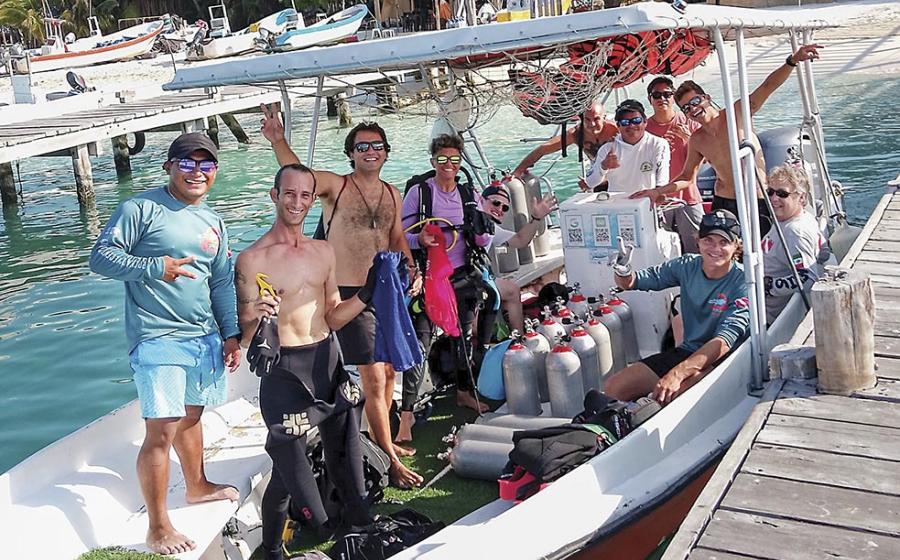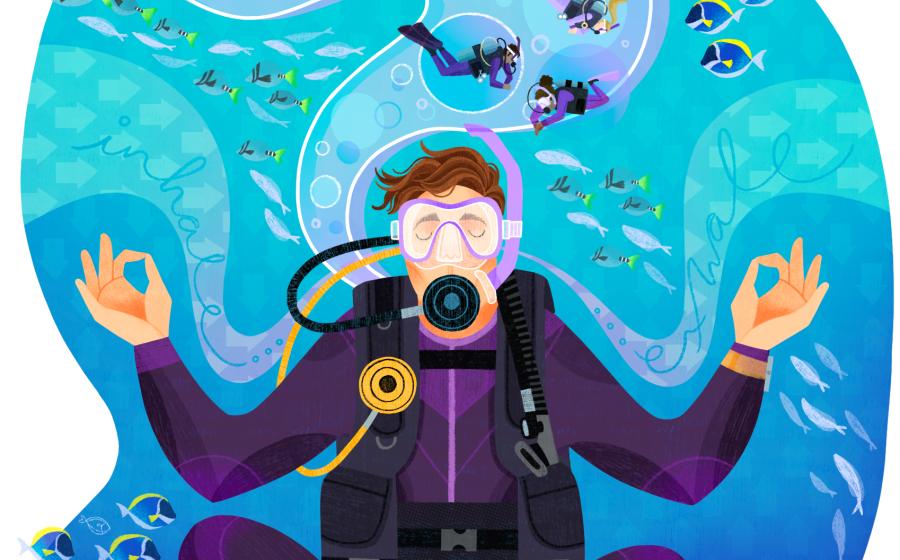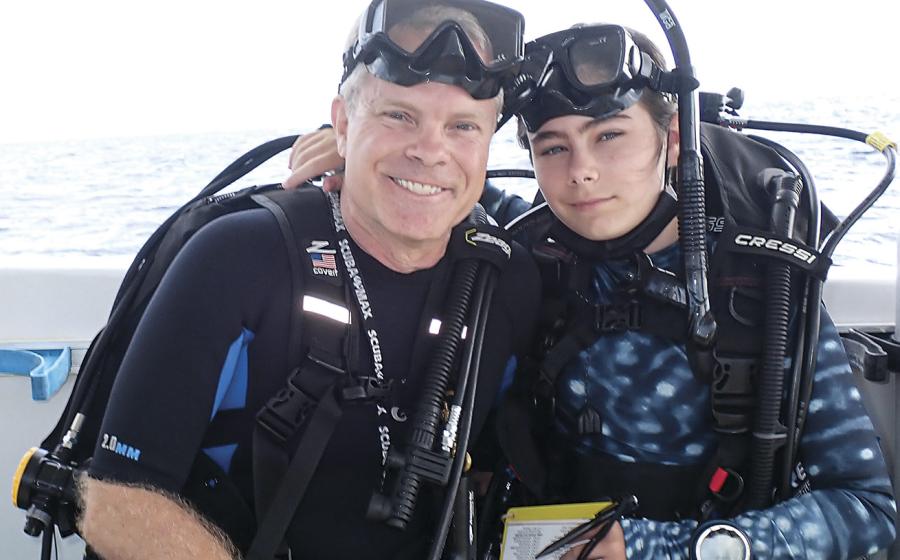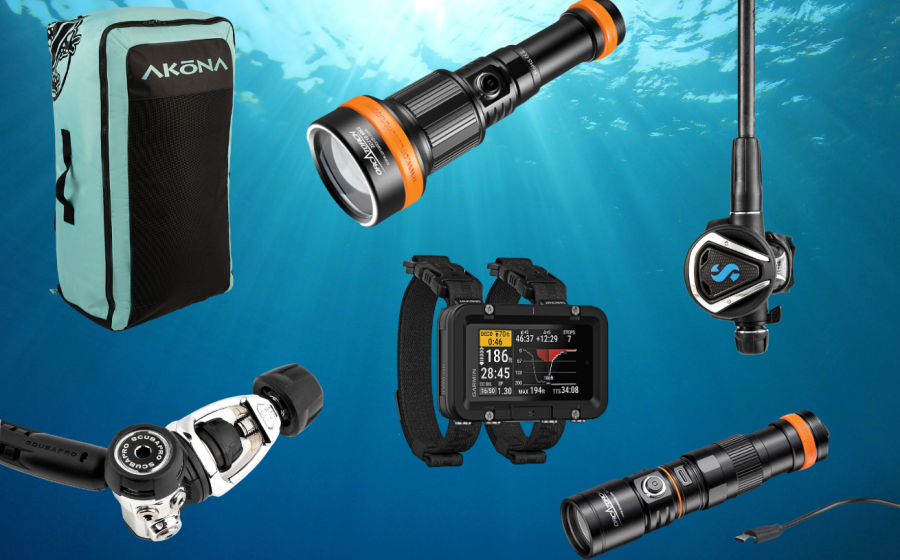Offshore San Diego
As I giant stride into 3,000 feet of deep Pacific blue, a feeling of unreality overtakes me. My system is flooded with adrenaline as I follow the sharkmaster down the long, yellow rope leading to the submerged shark cage. The water is alive with Pacific blue sharks, gliding effortlessly around the steel contraption.
We enter the cage and settle in to watch as our sharkmaster, Jessie, holds out her chainmailed hand with a mackerel in it. Suddenly, from the left, a sleek blue about three feet long begins a high-speed run. Jessie calmly floats outside the the safety of the cage as the shark hurtles past, snatching half the fish from her hand and streaking off. Another shark darts in and tries to snatch the rest, but Jessie keeps her hold on it.
As the blue shakes its head back and forth, furiously trying to break free with the piece of fish, I can see the shark's gills pumping water in and out, and an eerie, secondary eyelid close over its eye. Finally, Jessie lets go and the shark breaks away with its fish, darting right in front of us as it zooms off into the distance.
You don't often get the rush of watching a blue shark feed like that. In fact, divers rarely get to see blue sharks at all. They're pelagic hunters who favor the deepest oceans. In order to see them, we have traveled 20 miles from land and enticed them to the shallows by chumming the waters.
Shark diving off San Diego is an unforgettable all-day trip, but frankly, it's not for everyone. It starts with long rides through unpredictable open-ocean waters. Diving from a drifting boat into thousands of feet of water can be disorienting, and some find the cage claustrophobic. But the payoff is priceless. Read all you want to about the biology of sharks, but until you've seen the business end of one in action, you can't truly know the grace, power and efficiency of these great fish. Photographers: you'll go nuts over the close-up potential.
I turn and peer downward into the blue abyss. Emerging from haze is the unmistakable blunt-snout form of a mako shark, the more menacing cousin of the Pacific blue. The mako's mouth is half open, full of nasty-looking teeth, and it's coming straight up toward us at high speed. All I see are mouth and teeth and coal-black eyes.
This fellow looks to be at least six feet long and he glides toward us until he is about 15 feet away from the cage, and suddenly, he turns away and disappears back into the depths. Gone--just like that. Also gone is any lingering media-fueled fear of sharks as mindless killing machines. It's been replaced with fascination, respect and admiration.
Dive In: Offshore San Diego
The Drill: Shark diving off San Diego is an all-day affair and involves long boat rides to deep water 10 to 20 miles offshore. The boat doesn't anchor, making it susceptible to swells and wave action. Motion sickness remedies are recommended even for iron stomachs.
Once at the site, the shark cage is tethered to the dive vessel about 25 feet from the boat and 15 feet below the surface for a mandatory practice dive. This allows divers to fine-tune their weighting (you need to add an extra four to six pounds so you can stand securely in the cage), to remove all extraneous gear, and practice opening the cage doors under water. Then the chumming begins.
When the sharks have gathered, the sharkmaster escorts each diver into the cage, which holds three people at a time. The sharkmaster remains outside, baiting the sharks up to the cage. Divers remain in the cage for about 40 to 60 minutes at a time and typically get two turns in the cage per trip.
The Odds: The encounter rate is about 95 percent for blue sharks and 25 percent for makos.
Water Conditions: This is open-ocean diving. There is no visible bottom, a fact that can be disorienting for some divers. Water temperatures range from 62F to 70F. A 3mm wetsuit is minimum coverage for summer, but you'll need at least a full 7mm suit for winter. Shark diving season is year-round, though diving conditions are best from spring to fall when visibility ranges from 40 to 100 feet.
Dive Operator: San Diego Shark Diving Expeditions, (888) sd-shark or (619) 299-8560.
As I giant stride into 3,000 feet of deep Pacific blue, a feeling of unreality overtakes me. My system is flooded with adrenaline as I follow the sharkmaster down the long, yellow rope leading to the submerged shark cage. The water is alive with Pacific blue sharks, gliding effortlessly around the steel contraption.
We enter the cage and settle in to watch as our sharkmaster, Jessie, holds out her chainmailed hand with a mackerel in it. Suddenly, from the left, a sleek blue about three feet long begins a high-speed run. Jessie calmly floats outside the the safety of the cage as the shark hurtles past, snatching half the fish from her hand and streaking off. Another shark darts in and tries to snatch the rest, but Jessie keeps her hold on it.
As the blue shakes its head back and forth, furiously trying to break free with the piece of fish, I can see the shark's gills pumping water in and out, and an eerie, secondary eyelid close over its eye. Finally, Jessie lets go and the shark breaks away with its fish, darting right in front of us as it zooms off into the distance.
You don't often get the rush of watching a blue shark feed like that. In fact, divers rarely get to see blue sharks at all. They're pelagic hunters who favor the deepest oceans. In order to see them, we have traveled 20 miles from land and enticed them to the shallows by chumming the waters.
Shark diving off San Diego is an unforgettable all-day trip, but frankly, it's not for everyone. It starts with long rides through unpredictable open-ocean waters. Diving from a drifting boat into thousands of feet of water can be disorienting, and some find the cage claustrophobic. But the payoff is priceless. Read all you want to about the biology of sharks, but until you've seen the business end of one in action, you can't truly know the grace, power and efficiency of these great fish. Photographers: you'll go nuts over the close-up potential.
I turn and peer downward into the blue abyss. Emerging from haze is the unmistakable blunt-snout form of a mako shark, the more menacing cousin of the Pacific blue. The mako's mouth is half open, full of nasty-looking teeth, and it's coming straight up toward us at high speed. All I see are mouth and teeth and coal-black eyes.
This fellow looks to be at least six feet long and he glides toward us until he is about 15 feet away from the cage, and suddenly, he turns away and disappears back into the depths. Gone--just like that. Also gone is any lingering media-fueled fear of sharks as mindless killing machines. It's been replaced with fascination, respect and admiration.
Dive In: Offshore San Diego
The Drill: Shark diving off San Diego is an all-day affair and involves long boat rides to deep water 10 to 20 miles offshore. The boat doesn't anchor, making it susceptible to swells and wave action. Motion sickness remedies are recommended even for iron stomachs.
Once at the site, the shark cage is tethered to the dive vessel about 25 feet from the boat and 15 feet below the surface for a mandatory practice dive. This allows divers to fine-tune their weighting (you need to add an extra four to six pounds so you can stand securely in the cage), to remove all extraneous gear, and practice opening the cage doors under water. Then the chumming begins.
When the sharks have gathered, the sharkmaster escorts each diver into the cage, which holds three people at a time. The sharkmaster remains outside, baiting the sharks up to the cage. Divers remain in the cage for about 40 to 60 minutes at a time and typically get two turns in the cage per trip.
The Odds: The encounter rate is about 95 percent for blue sharks and 25 percent for makos.
Water Conditions: This is open-ocean diving. There is no visible bottom, a fact that can be disorienting for some divers. Water temperatures range from 62F to 70F. A 3mm wetsuit is minimum coverage for summer, but you'll need at least a full 7mm suit for winter. Shark diving season is year-round, though diving conditions are best from spring to fall when visibility ranges from 40 to 100 feet.
Dive Operator: San Diego Shark Diving Expeditions, (888) sd-shark or (619) 299-8560.










